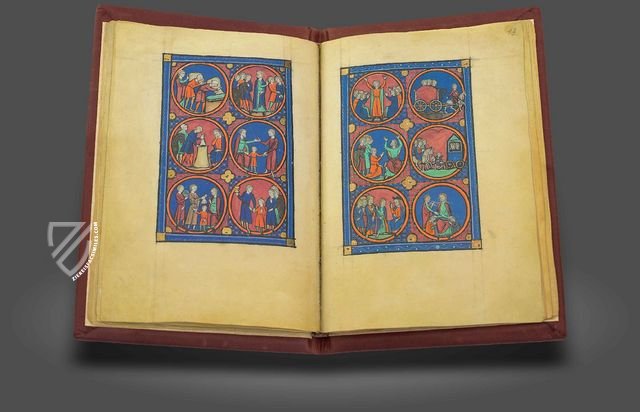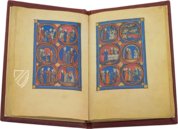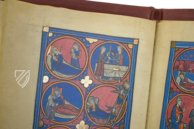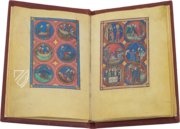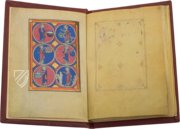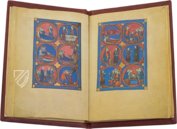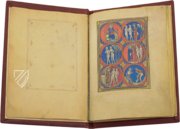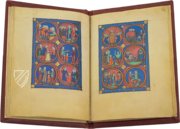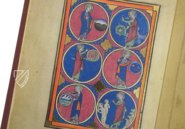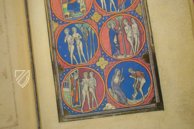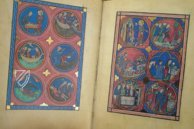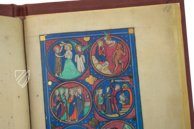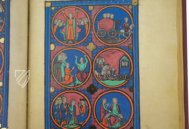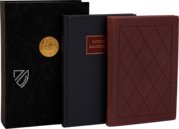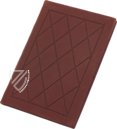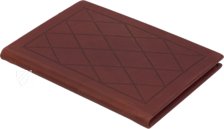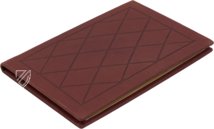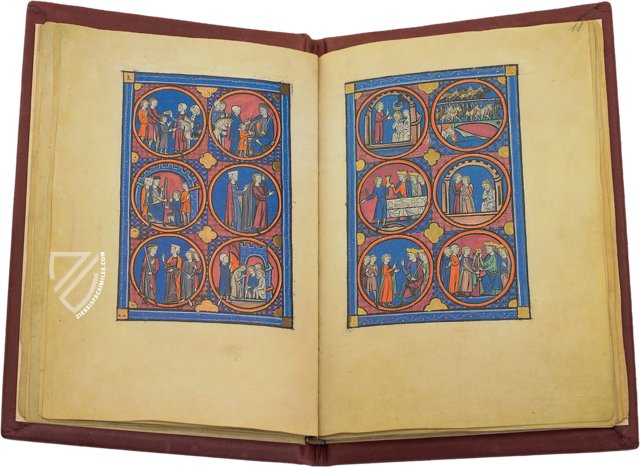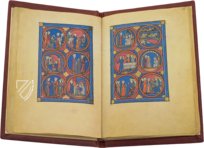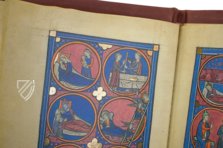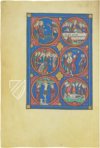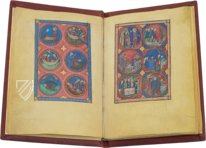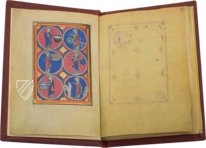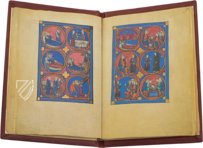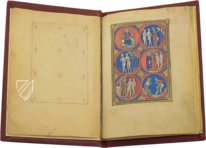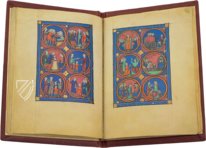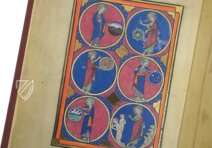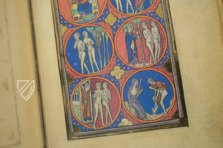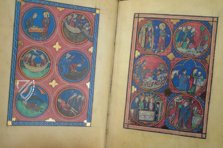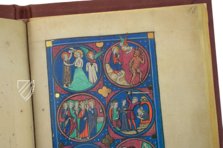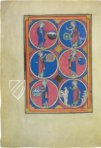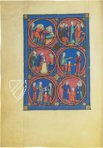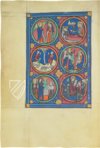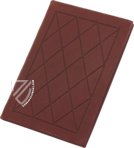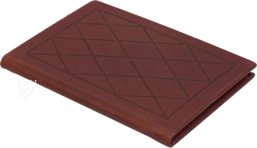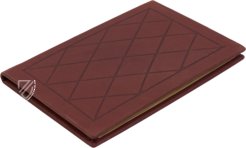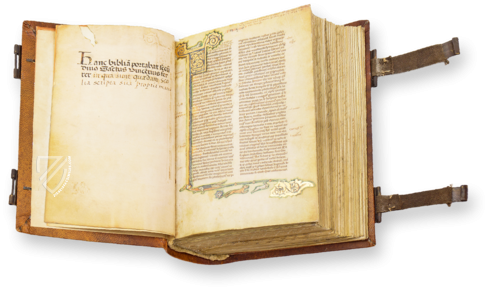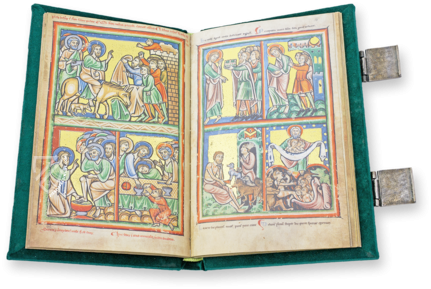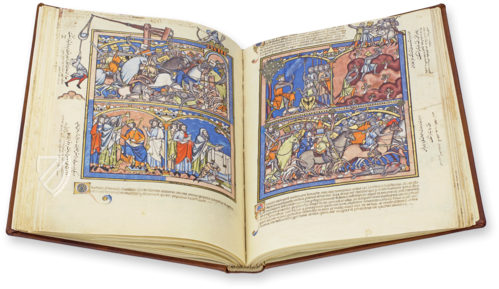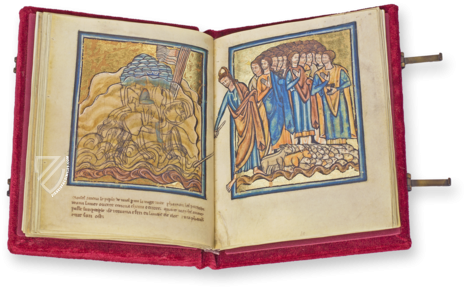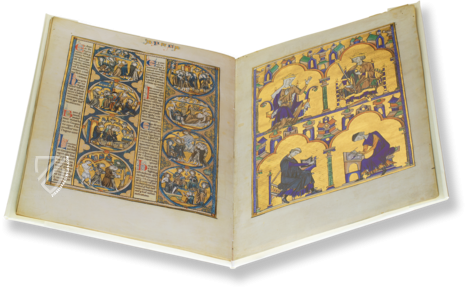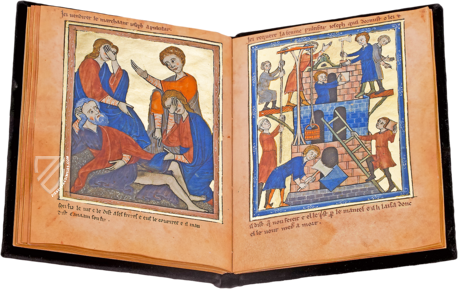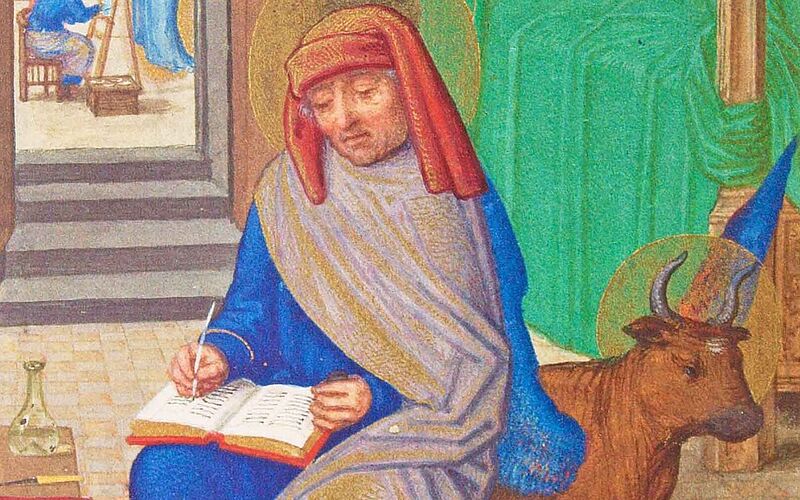Gothic Picture Bible
The so-called Gothic Picture Bible was created between 1250 and 1274 by unknown masters and is one of the highlights of 13th century French book art. In the prefatory picture cycle of 14 pages at the beginning of the manuscript, the stories of the Bible are told to the viewer entirely without texts: Instead, a captivating pictorial program of 84 wonderful medallion miniatures introduces us to the most important events from the Old and New Testaments. The radiant images are entirely indebted to the French High Gothic style and show the biblical figures in elegant robes and in front of sophisticated Gothic architecture. With their impressive colour scheme of dominant red and blue, but also bright gold, the miniatures are reminiscent of the gorgeous stained-glass windows of Gothic churches of this time. The colourful masterpiece came to Vienna from Ambras Castle in 1806 and is now kept in the Vienna National Library.
The Gothic Picture Bible
The so-called Gothic Picture Bible counts as part of the highpoint of 13th century French book art and is safely stored today among countless other treasures in the National Library of Vienna. Lacking any text, the 84 Old and New Testament scenes in total are impressively displayed and owe much to their clearly arranged 14 page layout. Inspired by the magnificent style of gothic architecture as well as bright stain glass windows, the miniaturist created splendid colors to bring biblical stories to life before your eyes.
A Picture Bible in the French, Gothic Style
After the large formats typical of the Romanesque style, the smaller formatted prayer books and bibles of the Gothic period came into use. In this tradition, we find the Gothic Picture Bible, which both from its outer appearance as well as its inner layout are in line with the contemporary currents in French art and architecture of the time. The famous Bible Moralisée, with its light, colorful miniatures of impressive biblical scenes, originated around the middle of the 14th century – perhaps in Paris. In doing so, it completely dispenses with the usual text and relies entirely on the fascinating power of the images. From the Old Testament story of Genesis, to the elaborately painted story of Joseph, and many of the stories of New Testament, like the Annunciation, birth, and childhood of Christ, the book ultimately ends with the Last Judgment.
Biblical Stories in Stunning Colors
The 14 illuminated page Bible is entirely covered in pictures. At any one time, three pairs of round medallions comprise the Old and New Testament scenes, which are smartly substituted for the text that would usually accompany these stories. Elegant figures, with their long, narrow bodies that are typical of the art of the High Gothic period, are arrayed in flexible, falling folds of garments. The story is masterfully told with very few resources, therefore relying on the graceful gestures and attributes of the characters to tell the story. For example, a six-stage work depicting the Genesis of life is on the first page, which increasingly presents everything in the order in which they were created: light, water, animals, and then eventually humans in the form of Adam and Eve. This terrific invention in manuscript art testifies to the skill of the miniaturists and is reminiscent of the Gothic-style stained glass windows, which often display similar motifs in a similar manner.
Artistic Ornaments, Valuable Gold
The exciting design of the background scenery also plays a significant role here. The six medallions are concentrated in a rectangular frame, connected with additional small pictures and architectural ornamentation, and appear as if they were quatrefoils. By varying the color and patterns, every aspect of the pictures offers a new impression. The colorful design, specially colored with bright blue and intense red, is complimented by the skillful implementation of gold. This combination lends much-needed finishing touches to the miniatures and their Gothic elegance. The Gothic Picture Bible offers a textless impression of the piety of the Late Middle Ages as well as an example of the high art of 13th Century France.
Codicology
- Alternative Titles
- Gotische Bilderbibel
- Size / Format
- 408 pages / 17.5 × 13.2 cm
- Origin
- France
- Date
- 1250–1274
- Style
- Genre
- Language
- Script
- Gothic Textura
- Illustrations
- 14-page picture cycle with a total of 84 medallion miniatures depicting stories from the Old and New Testaments
- Content
- Bible and psalter with prefatory picture cycle
The Gothic Picture Bible
Jacob’s Ladder
The dream of Jacob, patriarch of the Israelites, is generally interpreted as symbolizing the obligations and inheritance of God’s chosen people, although this is debated. In Christian theology, the ladder symbolizes the perpetual intercourse between Heaven and Earth. This miniature medallion shows Jacob reclining in deep sleep and wrapped in a blue blanket as the ladder leads directly to Jesus, representing his fulfillment of Jacob’s dream envisioning the reunion of God and mankind.
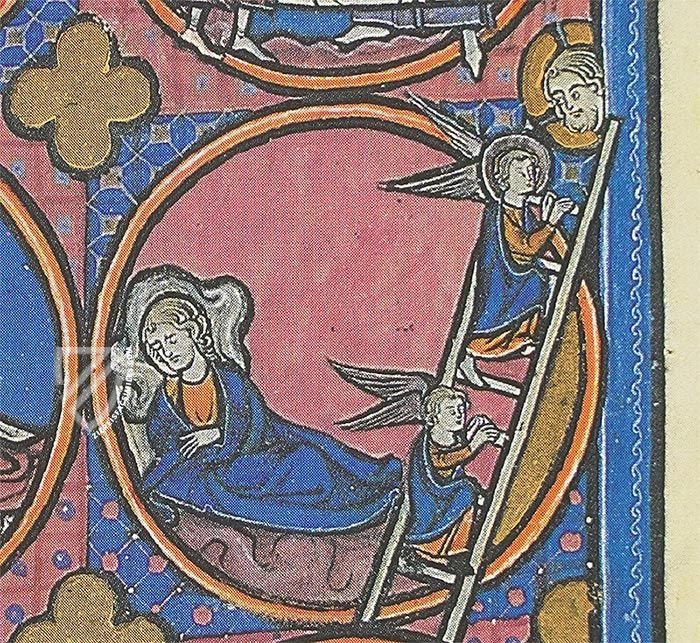
The Gothic Picture Bible
Scenes from the Passion Cycle
Although the Passion can consist of nearly 20 episodes, this page distills it down to the six most important scenes in medallion miniatures with alternating red-blue patterned backgrounds and plenty of gold leaf. Despite the size of the miniatures, the figures have expressive pale faces with strong glances and expressive hand gestures. An unusual feature of the manuscript is that Jesus is depicted as being beardless.
In the upper left, Jesus is first shown entering Jerusalem on Palm Sunday as a man lays down his cloak, followed by the Last Supper; the middle pair shows Judas’ Kiss in the Garden of Gethsemane and the Flagellation of Christ; at the bottom we see the Crucifixion and finally the Entombment of Christ as the Three Marys look on.
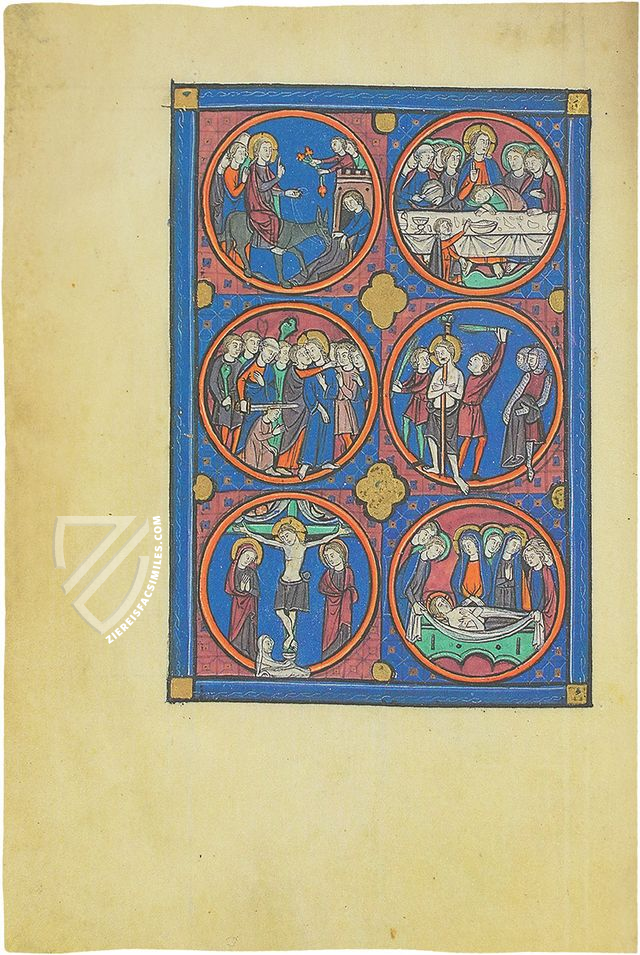
#1 Gotische Bilderbibel
Language: German
- Treatises / Secular Books
- Apocalypses / Beatus
- Astronomy / Astrology
- Bestiaries
- Bibles / Gospels
- Chronicles / History / Law
- Geography / Maps
- Saints' Lives
- Islam / Oriental
- Judaism / Hebrew
- Single Leaf Collections
- Leonardo da Vinci
- Literature / Poetry
- Liturgical Manuscripts
- Medicine / Botany / Alchemy
- Music
- Mythology / Prophecies
- Psalters
- Other Religious Books
- Games / Hunting
- Private Devotion Books
- Other Genres
- Afghanistan
- Armenia
- Austria
- Belgium
- Belize
- Bosnia and Herzegovina
- China
- Colombia
- Costa Rica
- Croatia
- Cyprus
- Czech Republic
- Denmark
- Egypt
- El Salvador
- Ethiopia
- France
- Germany
- Greece
- Guatemala
- Honduras
- Hungary
- India
- Iran
- Iraq
- Israel
- Italy
- Japan
- Jordan
- Kazakhstan
- Kyrgyzstan
- Lebanon
- Liechtenstein
- Luxembourg
- Mexico
- Morocco
- Netherlands
- Palestine
- Panama
- Peru
- Poland
- Portugal
- Romania
- Russia
- Serbia
- Spain
- Sri Lanka
- Sweden
- Switzerland
- Syria
- Tajikistan
- Turkey
- Turkmenistan
- Ukraine
- United Kingdom
- United States
- Uzbekistan
- Vatican City
- A. Oosthoek, van Holkema & Warendorf
- Aboca Museum
- Ajuntament de Valencia
- Akademie Verlag
- Akademische Druck- u. Verlagsanstalt (ADEVA)
- Aldo Ausilio Editore - Bottega d’Erasmo
- Alecto Historical Editions
- Alkuin Verlag
- Almqvist & Wiksell
- Amilcare Pizzi
- Andreas & Andreas Verlagsbuchhandlung
- Archa 90
- Archiv Verlag
- Archivi Edizioni
- Arnold Verlag
- ARS
- Ars Magna
- ArtCodex
- AyN Ediciones
- Azimuth Editions
- Badenia Verlag
- Bärenreiter-Verlag
- Belser Verlag
- Belser Verlag / WK Wertkontor
- Benziger Verlag
- Bernardinum Wydawnictwo
- BiblioGemma
- Biblioteca Apostolica Vaticana (Vaticanstadt, Vaticanstadt)
- Bibliotheca Palatina Faksimile Verlag
- Bibliotheca Rara
- Boydell & Brewer
- Bramante Edizioni
- Bredius Genootschap
- Brepols Publishers
- British Library
- C. Weckesser
- Caixa Catalunya
- Canesi
- CAPSA, Ars Scriptoria
- Caratzas Brothers, Publishers
- Carus Verlag
- Casamassima Libri
- Centrum Cartographie Verlag GmbH
- Chavane Verlag
- Christian Brandstätter Verlag
- Circulo Cientifico
- Club Bibliófilo Versol
- Club du Livre
- CM Editores
- Collegium Graphicum
- Collezione Apocrifa Da Vinci
- Comissão Nacional para as Comemorações dos Descobrimentos Portugueses
- Coron Verlag
- Corvina
- CTHS
- D. S. Brewer
- Damon
- De Agostini/UTET
- De Nederlandsche Boekhandel
- De Schutter
- Deuschle & Stemmle
- Deutscher Verlag für Kunstwissenschaft
- DIAMM
- Droz
- E. Schreiber Graphische Kunstanstalten
- Ediciones Boreal
- Ediciones Grial
- Ediclube
- Edições Inapa
- Edilan
- Editalia
- Edition Deuschle
- Edition Georg Popp
- Edition Leipzig
- Edition Libri Illustri
- Editiones Reales Sitios S. L.
- Éditions de l'Oiseau Lyre
- Editions Medicina Rara
- Editorial Casariego
- Editorial Mintzoa
- Editrice Antenore
- Editrice Velar
- Edizioni Edison
- Egeria, S.L.
- Eikon Editores
- Electa
- Emery Walker Limited
- Enciclopèdia Catalana
- Eos-Verlag
- Ephesus Publishing
- Ernst Battenberg
- Eugrammia Press
- Extraordinary Editions
- Fackelverlag
- Facsimila Art & Edition
- Facsimile Editions Ltd.
- Facsimilia Art & Edition Ebert KG
- Faksimile Verlag
- Feuermann Verlag
- Folger Shakespeare Library
- Franco Cosimo Panini Editore
- Friedrich Wittig Verlag
- Fundación Hullera Vasco-Leonesa
- G. Braziller
- Gabriele Mazzotta Editore
- Gebr. Mann Verlag
- Gesellschaft für graphische Industrie
- Getty Research Institute
- Giovanni Domenico de Rossi
- Giunti Editore
- Graffiti
- Grafica European Center of Fine Arts
- Guido Pressler
- Guillermo Blazquez
- Gustav Kiepenheuer
- H. N. Abrams
- Harrassowitz
- Harvard University Press
- Helikon
- Hendrickson Publishers
- Henning Oppermann
- Herder Verlag
- Hes & De Graaf Publishers
- Hoepli
- Holbein-Verlag
- Houghton Library
- Hugo Schmidt Verlag
- Idion Verlag
- Il Bulino, edizioni d'arte
- ILte
- Imago
- Insel Verlag
- Insel-Verlag Anton Kippenberger
- Instituto de Estudios Altoaragoneses
- Instituto Nacional de Antropología e Historia
- Introligatornia Budnik Jerzy
- Istituto dell'Enciclopedia Italiana - Treccani
- Istituto Ellenico di Studi Bizantini e Postbizantini
- Istituto Geografico De Agostini
- Istituto Poligrafico e Zecca dello Stato
- Italarte Art Establishments
- Jan Thorbecke Verlag
- Johnson Reprint Corporation
- Josef Stocker
- Josef Stocker-Schmid
- Jugoslavija
- Karl W. Hiersemann
- Kasper Straube
- Kaydeda Ediciones
- Kindler Verlag / Coron Verlag
- Kodansha International Ltd.
- Konrad Kölbl Verlag
- Kurt Wolff Verlag
- La Liberia dello Stato
- La Linea Editrice
- La Meta Editore
- Lambert Schneider
- Landeskreditbank Baden-Württemberg
- Leo S. Olschki
- Les Incunables
- Liber Artis
- Library of Congress
- Libreria Musicale Italiana
- Lichtdruck
- Lito Immagine Editore
- Lumen Artis
- Lund Humphries
- M. Moleiro Editor
- Maison des Sciences de l'homme et de la société de Poitiers
- Manuscriptum
- Martinus Nijhoff
- Maruzen-Yushodo Co. Ltd.
- MASA
- Massada Publishers
- McGraw-Hill
- Metropolitan Museum of Art
- Militos
- Millennium Liber
- Müller & Schindler
- Nahar - Stavit
- Nahar and Steimatzky
- National Library of Wales
- Neri Pozza
- Nova Charta
- Oceanum Verlag
- Odeon
- Orbis Mediaevalis
- Orbis Pictus
- Österreichische Staatsdruckerei
- Oxford University Press
- Pageant Books
- Parzellers Buchverlag
- Patrimonio Ediciones
- Pattloch Verlag
- PIAF
- Pieper Verlag
- Plon-Nourrit et cie
- Poligrafiche Bolis
- Presses Universitaires de Strasbourg
- Prestel Verlag
- Princeton University Press
- Prisma Verlag
- Priuli & Verlucca, editori
- Pro Sport Verlag
- Propyläen Verlag
- Pytheas Books
- Quaternio Verlag Luzern
- Reales Sitios
- Recht-Verlag
- Reichert Verlag
- Reichsdruckerei
- Reprint Verlag
- Riehn & Reusch
- Roberto Vattori Editore
- Rosenkilde and Bagger
- Roxburghe Club
- Salerno Editrice
- Saltellus Press
- Sandoz
- Sarajevo Svjetlost
- Schöck ArtPrint Kft.
- Schulsinger Brothers
- Scolar Press
- Scrinium
- Scripta Maneant
- Scriptorium
- Shazar
- Siloé, arte y bibliofilia
- SISMEL - Edizioni del Galluzzo
- Sociedad Mexicana de Antropología
- Société des Bibliophiles & Iconophiles de Belgique
- Soncin Publishing
- Sorli Ediciones
- Stainer and Bell
- Studer
- Styria Verlag
- Sumptibus Pragopress
- Szegedi Tudomànyegyetem
- Taberna Libraria
- Tarshish Books
- Taschen
- Tempus Libri
- Testimonio Compañía Editorial
- Thames and Hudson
- The Clear Vue Publishing Partnership Limited
- The Facsimile Codex
- The Folio Society
- The Marquess of Normanby
- The Richard III and Yorkist History Trust
- Tip.Le.Co
- TouchArt
- TREC Publishing House
- TRI Publishing Co.
- Trident Editore
- Tuliba Collection
- Typis Regiae Officinae Polygraphicae
- Union Verlag Berlin
- Universidad de Granada
- University of California Press
- University of Chicago Press
- Urs Graf
- Vallecchi
- Van Wijnen
- VCH, Acta Humaniora
- VDI Verlag
- VEB Deutscher Verlag für Musik
- Verlag Anton Pustet / Andreas Verlag
- Verlag Bibliophile Drucke Josef Stocker
- Verlag der Münchner Drucke
- Verlag für Regionalgeschichte
- Verlag Styria
- Vicent Garcia Editores
- W. Turnowski Ltd.
- W. Turnowsky
- Waanders Printers
- Wiener Mechitharisten-Congregation (Wien, Österreich)
- Wissenschaftliche Buchgesellschaft
- Wissenschaftliche Verlagsgesellschaft
- Wydawnictwo Dolnoslaskie
- Xuntanza Editorial
- Zakład Narodowy
- Zollikofer AG

